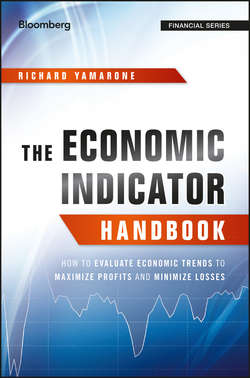Читать книгу The Economic Indicator Handbook - Ричард Ямароне - Страница 16
На сайте Литреса книга снята с продажи.
Chapter 1
The Daily Blotter
The Bloomberg Financial Conditions Monitor
ОглавлениеAfter the 2008 financial crisis, it became increasingly important for economists to be aware of the amount of stress ruminating throughout the financial system, which lead to the creation of several financial market stress indicators.
The Bloomberg Financial Market Conditions Monitor (FCON <GO>) shown in Exhibit 1.10 contains the individual components of the U.S. Financial Conditions Index (FCON) in the three asset classes, a graphical history of the index, and the latest and 52-week range of each of the components in the FCON.
Exhibit 1.10 Bloomberg Financial Market Conditions Monitor
Source: Bloomberg
The FCON is an index of three equally weighted (33 percent each) asset classes, the Money Market, the Bond Market, and the Equity Market. The headline index comprises a total of 10 indicators. In each of the three asset classes are instruments that represent their respective category.
In the Money Market group there are three measures (the U.S. LIBOR/OIS Spread, the U.S. TED spread, and the U.S. commercial paper/T-bill spread), each carrying an 11.1 percent weight in the total index. The Bond Market section includes five measures (the BAA-10-year Treasury spread, the U.S. High-Yield-10-year Treasury spread, the 10-year swap-Treasury spread, the U.S. muni-10-year Treasury spread, and the swaption volatility index), each possessing a 6.7 percent weight in the headline index. The Equity market group contains the S&P 500 five-year moving average and the VIX Index of S&P 500 volatility, and each of these carries a 16.7 percent weight.
As Exhibit 1.11 shows, there were seven notable events/periods since late 2007, when financial conditions were flashing worry signs.
Exhibit 1.11 Bloomberg Financial Market Conditions Index – History
Source: Bloomberg
In late 2007, the liquidity issues surfaced in the interbank funding market, while the Bank of England provided a loan facility for Northern Rock, a major mortgage provider in the United Kingdom. This was essentially the first of several sizable declines in the Financial Conditions Index. The Federal Reserve commenced its rate-cutting campaign in September 2007 and continued to slash its target rate throughout 2008, which had a steady deceleration in financial conditions. Also in 2008, the primary cause for the momentous plunge in the Financial Conditions Index during September of that year was the collapse of Lehman Brothers. This would be the first major domino to fall in a string of global bank failures, which rattled the markets for years. Congress subsequently provided a $700 billion Troubled Asset Relief Program (TARP), purchasing the assets of failing banks and injecting liquidity into the melting financial markets. This move, in combination with monetary policy accommodation and other actions, soon resulted in an increase in the Financial Conditions Index as fears of calamity subsided through 2009.
In mid-2010, the euro area started to unravel with fears of a Greek default and possible exit from the Eurozone. The International Monetary Fund (IMF) and European nations created the Financial Stabilization Mechanism and Facility of €750 billion and agreed to loan €110 billion to Greece. This ultimately sent the Financial Conditions Index back into negative territory.
In July and August of 2011, conditions deteriorated once again on Greek fears, and the ratings agency Standard & Poor's cut America's credit rating from AAA to AA+ amid concerns that policy makers wouldn't be able to raise revenues and reduce spending enough to reduce its burgeoning budget deficit. The Bank of England made asset purchases. This stabilized the financial markets.
Then in early 2012, Europe's situation grew more dire. Spain was up against the ropes, and the Republic of Cyprus needed an emergency loan. The European Central Bank (ECB) soon announces a bond-buying program and financial market stress is arrested.
Conditions returned to a relatively safe status until a temporary hit in August of 2015, when the People's Bank of China devalued its currency and China experienced a tremendous sell-off in its stock market in 2015. This sent jitters throughout the markets, since the concerns were exacerbated by the expectations of a Federal Reserve rate increase. The Financial Conditions Index fell, but returned to less worrisome levels once the fears dissipated.
